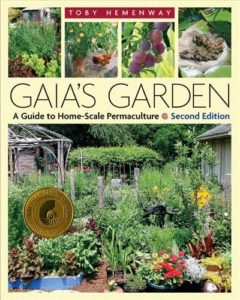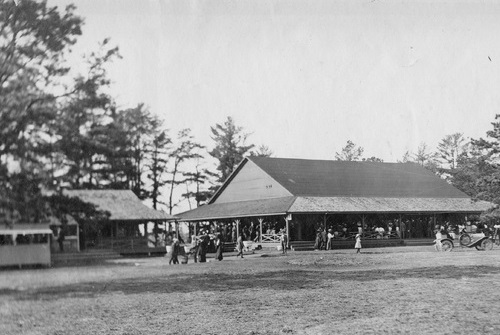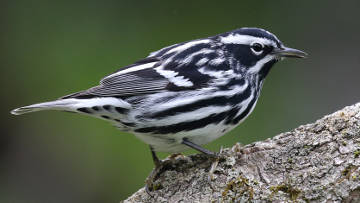
Permaculture
Each year, I try to build my gardening skills by modestly improving my garden plot or by planting a new kind of vegetable. This spring I am upping my horticultural game by reading Gaia’s Garden: A Guide to Home-Scale Permaculture by Toby Hemenway. My aspirations, however, have a cost: my attempt to understand and incorporate the idea of permaculture into my gardening has come at the expense of my time normally spent reading historical and literary works.
Permaculture is an approach to gardening that tries to work with nature rather than against it. The goal is to create a local ecosystem where each element cooperatively contributes multiple functions to the whole. The result is a more diverse, more natural, more productive, and more beautiful garden. And once this garden system gets up and running, nature does most of the work required to sustain it—and will theoretically give me more time to read history and literature in my garden rather than working on it.
The more I learn about using sustainable and permaculture principles in my garden, the more I see how they can be applied to other settings and contexts. Here is a sampling of some permaculture principles, according to Hemenway:
- Connect – create useful relationships and time-saving connections: “the number of connections among elements creates a healthy, diverse ecosystem, not the number of elements”
- Each element performs multiple functions
- Each function is supported by multiple elements
- Use small-scale, intensive systems – “start at your doorstep with the smallest systems that will do the job and build on your successes”
- Optimize edge – “the intersection of two environments [is] the most diverse place in a system [and] is where energy and materials accumulate”
- Turn problems into solutions
- Mistakes are tools for learning – “evaluate your trials. Making mistakes is a sign you’re trying to do things better. There is usually little penalty for mistakes if you learn from them.”
I now realize that I have been intuitively following many of these principles as I have been growing the Westborough Center. I prioritize creating programs that not only teach about Westborough’s history and culture but can also add something to our town’s historical record at the same time, such as the Photographer-in-Residence program. We are currently in the process of revamping this program for the fall, but the idea behind the original one will remain: tap into Westborough’s long history with photography, support the talent of local photographers, share their work with the community, and add their work to the archive so that future residents of Westborough can gain insight into how we live our lives today. All of these elements work together and strengthen one another, all while keeping an eye on the past, present, and future. (By the way, if you are interested in helping to design this new program, contact me.)
If I had to pick my favorite permaculture principle, it is “Optimize edge,” i.e., take advantage of the dynamism that is created when two environments meet one another. This border space is where creativity springs and where new possibilities emerge. Many local history programs enshrine the past, but such a learning environment inevitably becomes stagnant and slowly loses relevance to the present. History is much more exciting and interesting when it sits at the edge of both the past and the present. When we pay attention to this space, the questions we ask are more relevant, the inquiries are more engaging, and our understanding of the present and future becomes richer and more nuanced.
This edge also has big payoffs when it comes to cultural interaction. A couple years ago at one of the Arts in Common festivals here in town, I saw two musicians performing, one was playing a traditional Indian musical instrument and the other an electric guitar. They first played a classical Indian song, and the additional sound of the electric guitar took a song that was meant for a concert hall and made it appropriate for a festival setting. And when they flipped the script and the guitarist played a Bob Dylan song, the addition of the Indian instrument transformed the familiar tune into one that sounded entirely new. These two musicians were creating music together in the border space that normally separates their respective musical genres, and the crowd loved it. My hope is that Westborough can do more to cultivate and capture the energy that is created when different cultural environments like these meet one another. (Again, if you have an idea for such cultural engagement, contact me and let’s see what we can do.)
In my embrace of permaculture principles, my garden is becoming a metaphor for how to grow organizations, conceptualize cultural change, and think about how our town can become even better than it already is. So even though my hands are spending more time in the dirt nowadays than my eyes are in books, the topics of history, culture, and Westborough are still rattling around in my head.
—Anthony Vaver, Local History Librarian
Suggested Reading:
* * *

Featured Images: Lake Chauncy
The Westborough Digital Repository is currently featuring images of Lake Chauncy. Many of us enjoy the beach, grounds, and hiking trails around Lake Chauncy but may not realize that in the early 1900’s, the area was home to Lake Chauncy Park, which drew people from all over Massachusetts.
The park was created by the Worcester Consolidated Railway Company as a way to increase its trolley business. The trolleys that connected Westborough to Boston transported throngs of visitors from the city to Lake Chauncy to enjoy dancing, picnicking, canoeing, bowling, and vaudeville shows. At the time, the park included a dance pavilion, restaurant, and a theater, and later a bowling alley and athletic fields were added. The fun all came to an end, however, when the dance pavilion, bowling alley, pool hall, and beer garden burned down in 1949.
Each time you visit the Westborough Digital Repository, you will see a rotating picture of Lake Chauncy featured on the front page, or you can see all of the photographs of Lake Chauncy in the database by clicking on the above picture of the Lake Chauncy Pavilion.
* * *
Nature Notes: May
Flowers are in bloom, birds are singing, and critters are gearing up for summer, so it must be May. Read about all of them in Annie Reid’s Nature Notes for May.
* * *
Did you enjoy reading this Westborough Center Pastimes newsletter? Then subscribe by e-mail and have the newsletter and other notices from the Westborough Center for History and Culture at the Westborough Public Library delivered directly to your e-mail inbox.
You can also read the current and past issues on the Web by clicking here.

